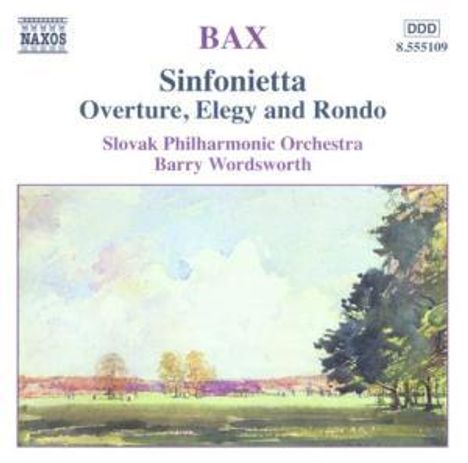Arnold Bax: Sinfonietta auf CD
Sinfonietta
Herkömmliche CD, die mit allen CD-Playern und Computerlaufwerken, aber auch mit den meisten SACD- oder Multiplayern abspielbar ist.

+Overture, Elegy & Rondo
- Künstler:
- Slowakische Philharmonie, Barry Wordsworth
- Label:
- Naxos
- Aufnahmejahr ca.:
- 1987
- Artikelnummer:
- 8475981
- UPC/EAN:
- 0747313510924
- Erscheinungstermin:
- 30.6.2003
Bax schrieb seine einsätzige, dreiteilige Sinfonietta im Mai 1932 und nannte sie Symphonische Phantasie. Obwohl nicht in der Größenordnung seiner Sinfonien, hat diese Musik eine ganz eigene Persönlichkeit, und die meisten der charakteristischsten Merkmale von Bax sind in ihr zu finden. In ihrer Vielfalt und ihren farbenfrohen und sich ständig verändernden orchestralen Texturen nimmt sie einen schnell in Bax' vielfältige und plötzlich wechselnde Stimmungen auf. Die Musik spielt kontinuierlich, wobei das Anfangsthema als eine Art Motto fungiert, das im Mittelteil wiederkehrt, während die dramatische schnelle Passage, die folgt, die Keime der im Schlussteil verwendeten Ideen enthält. Wie im Rondo des anderen hier eingeschlossenen Werkes spiegelt auch dieser letzte Satz das Ende von Bax' Gefühlsspektrum wider, indem er die düstereren und nachdenklicheren früheren Abschnitte scharf hervorhebt, obwohl die Musik gelegentlich in eine eher grüblerische Stimmung abzugleiten beginnt. Rasch verwandelt sich alles in rasante Musik, die vor dem triumphalen Höhepunkt, mit dem sie endet, mit "Fröhlich" gekennzeichnet ist.
Die Ouvertüre, Elegie und Rondo stammt aus dem Sommer 1927 und fällt damit zwischen Bax' Zweite und Dritte Symphonie. Obwohl 1938 veröffentlicht, wurde der Bestand an Partituren später bei einem Brand in seinem Verlagshaus vernichtet, und die Partituren waren nie allgemein zugänglich. Die Eröffnungsouvertüre ist gelegentlich allein, losgelöst vom Gesamtwerk, zu hören, und in ihrem Eröffnungsthema kommt Bax dem damaligen aktuellen Neoklassizismus am nächsten. Er beschrieb diese Eröffnungspassage als "an ein Konzert des 18. Jahrhunderts erinnernd", aber die lange verträumte Melodie des Mittelteils ist Bax pur. Die zentrale Elegie beginnt in einer Stimmung, die Bax als "ein wenig spektral" beschrieb, und führt uns nach einem Höhepunkt zu ruhiger Musik, die Bax "in der Art eines Wiegenliedes" gespielt haben möchte.
Product Information
Bax wrote his one-movement, three-sectioned, Sinfonietta in May 1932 and called it Symphonic Phantasy. Although not on the scale of his symphonies, this music has a special personality all its own and most of Bax’s most characteristic fingerprints may be found in it. In its variety and colourful and ever-changing orchestral textures it quickly absorbs one into Bax’s varied and suddenly changing moods. The music plays continually, the opening theme acting as something of a motto, returning in the middle section, while the dramatic fast passage which follows contains the seeds of the ideas used in the closing section. As in the Rondo of the other work here included, this last movement reflects the end of Bax’s emotional spectrum, throwing the more sombre and reflective earlier sections into sharp relief, though occasionally the music starts to slip into a more brooding mood. Quickly it all changes into fast music marked Gaily before the triumphal climax with which it ends.
The Overture, Elegy and Rondo dates from the summer of 1927 and thus falls between Bax’s Second and Third Symphony. Although published in 1938, the stock of scores was later destroyed in a fire at his publisher’s and it has never been widely available. The opening Overture has occasionally been heard on its own, detached from the complete work, and in its opening theme Bax comes the nearest he ever came to encompassing the then fashionable neo-classicism. He described this opening passage as ‘suggestive of an 18th-century concerto’, but the long dreamy middle-section melody is pure Bax. The central Elegy opens in a mood that Bax described as being ‘a little spectral’, and after a climax leads us to quiet music which Bax wants played ‘in the manner of a cradle song’.
Rezensionen
Gramophone 7/88: "Hier ist genug, um den Bax-Fan zu beglücken."Disk 1 von 1 (CD)
-
1 Elegy and Rondo: Overture
-
2 Elegy and Rondo: Elegy
-
3 Elegy and Rondo: Rondo
-
4 Sinfonietta: I. Molto moderato - Allegro
-
5 Sinfonietta: II. Tempo primo
-
6 Sinfonietta: Iii. Allegro
Mehr von Arnold Bax
-
Edmund RubbraKlavierkonzert G-Dur op.85CDVorheriger Preis EUR 19,99, reduziert um 0%Aktueller Preis: EUR 9,99
-
Arnold BaxVariationen für Orchester (Improvisationen)Super Audio CDAktueller Preis: EUR 19,99
-
Arnold BaxPhantasy für Viola & OrchesterCDAktueller Preis: EUR 19,99
-
Arnold BaxSymphonie Nr.2CDVorheriger Preis EUR 13,99, reduziert um 0%Aktueller Preis: EUR 12,99








